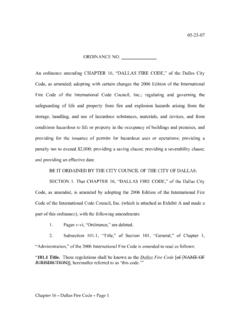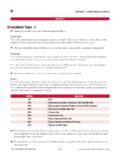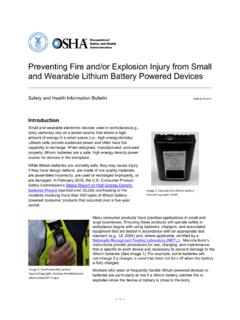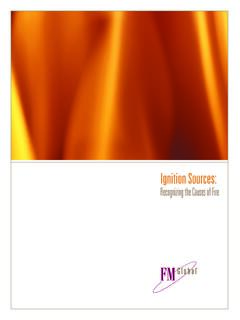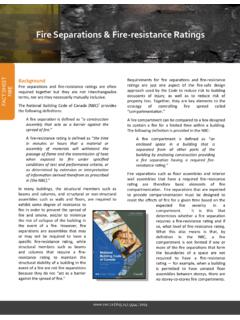Transcription of SCOTT SCBA - Riverside, California
1 SCOTT SCBA This Spiel is interactive. Guide your mouse cursor over a part of the SCBA and you will go directly to that part of the spiel. You can also continue on to page 2 and read the spiel without using the interactive parts of the SCBA picture. SCOTT AIR PAK Wire Frame TABLE OF CONTENTS Self-Contained Breathing Apparatus I. General Use and Description II. Components III. Cylinder IV. High Pressure Hose/RIC UAC V. Pressure Reducer VI. Low Pressure Hose/Mask Mounted Regulator Connection (MMR) VII. Mask Mounted Regulator (MMR)/Heads Up Display (HUD) VIII. Mask AV2000/AV3000 and Voice Amplifier IX. Back frame and harness X. PAK Alert XI.
2 SEMS/Remote Pressure Gauge XII. Single EBSS XIII. Types of SCOTT SCBA s in use by RFD. XIV. RIC PAK XV. Cleaning and Disinfection Procedures XVI. PPE and SCBA Donning XVII. SCBA Escape Procedures XVIII. Cylinder re-fill stations XIX. SCBA Repair and Maintenance GENERAL USE AND DESCRIPTION Self-Contained Breathing Apparatus (SCBA) shall be used by all personnel when the following conditions are met according to SOP #317 RFD SOP #317 states that SCBA s shall be worn and used by all personnel in the following conditions (THESE CONDITIONS ARE A MINIMUM): 1. The atmosphere is hazardous 2. The atmosphere is suspected of being hazardous 3. The atmosphere may rapidly become hazardous The above three areas are an absolute minimum.
3 The following information is better defined and should be used as a guideline with the SCBA. 1. Oxygen deficient atmospheres (oxygen levels below ) 2. Elevated temperatures 3. Presence of smoke or unburned products of combustion 4. Toxic Environments a. The atmosphere is hazardous. b. The atmosphere is suspected of being hazardous. c. The atmosphere may rapidly become hazardous. 5. In an active fire area. 6. Directly above an active fire area. 7. In a potential explosion or fire area, including gas leaks and fuel spills. 8. Where products of combustion are visible in the atmosphere, including vehicle fires and dumpster fires where invisible contaminants are suspected to be present ( Carbon Monoxide during overhaul).
4 9. Where toxic products are present, suspected to be present, or may be released without warning. 10. In any confined space which has not been tested to establish respiratory safety. This includes all personnel operating: In an active fire area. Directly above an active fire area. In a potential explosion or fire area, including gas leaks and fuel spills. Where products of combustion are visible in the atmosphere, including vehicle fires and dumpster fires where invisible contaminants are suspected to be present ( Carbon Monoxide during overhaul). Where toxic products are present, suspected to be present, or may be released without warning. In any confined space which has not been tested to establish respiratory safety.
5 In addition to the above, shall be worn by all personnel operating at fire incidents above ground, below ground or in any other area which is not, but which may become contaminated by products of combustion or other hazardous substances. In these circumstances only, the may be worn with the face piece removed. The wearing of in these situations provides that it will be immediately available for use if conditions change or if personnel are to enter an area where the use of is required. Premature removal of must be avoided at all times. This is particularly significant during overhaul when smoldering materials may produce increased quantities of carbon monoxide and other toxic products.
6 In these cases must be used or the atmosphere must be changed. In routine fire situations, the decision to remove shall be made by Company Officers, with the approval of Chief Officers, based on an evaluation of atmospheric conditions. Prior to removal, fire areas shall be thoroughly ventilated and, where necessary, continuous ventilation shall be provided. If there is any doubt about respiratory safety, use shall be maintained until the atmosphere is established to be safe by testing. Safety personnel shall be responsible for this determination. This is required in complex situations, particularly when toxic materials may be involved. An evaluation of all members of the Operations Division in the use of the shall be conducted both quarterly and annually.
7 Each member shall be able to demonstrate a high level of proficiency and compatibility with the under conditions which simulate those expected as a job requirement. Each member shall also demonstrate an effective face piece to skin seal of the face piece. COMPONENTS Cylinder High Pressure Hose/RIC UAC Pressure Reducer Low Pressure Hose/MMR Connection MMR and HUD AV2000/AV3000 Mask and Voice Amplifier Back Frame and Harness PAK Alert SEMS Remote Pressure Gauge Single EBS CYLINDER A. All of our cylinders are made by a local air supply company named Luxfur. B. The cylinder is made from 6061 T6 Aluminum, the process is called deep drawn, this process creates a seamless cylinder from one piece of aluminum.
8 C. The cylinder is constructed of aluminum, carbon fiber, fiberglass and resin. This is what is referred to as composite construction. D. The cylinder is then wrapped with carbon fiber strands, first helical wrapped then hoped wrapped again then helical wrapped again. The carbon fiber wrapping gives the cylinder the majority of its strength, without it, it would rupture at about 900 psi. After the carbon fiber wrapping is complete the cylinder is helical wrapped with fiberglass. This fiberglass wrapping is to protect the carbon fiber wrapping and any strength it adds is inconsequential. The cylinder is then finished off with a clear resin. E. All RFD Cylinders are composite.
9 F. All cylinders are hydrostatically tested every three years. G. All cylinders have a fifteen year service life. H. Cylinders are tested at 5/3 of their working pressure or to 7500 psi. I. There are five types of cylinders in use by the RFD today. 1. Hoop wrapped = Flat bottoms, painted yellow, oldest on the dept., body only fiberglass. These cylinders are almost out of service. 2. Total wrapped = Painted yellow, fiberglass wrapped on top and bottoms. 3. Total wrapped featherweight = not painted yellow, yellow look comes from pigment within the fiberglass. 4. Kevlar total wrapped = Kevlar around the bottle, wrapped with fiberglass and epoxy resin.
10 Appears whitish. 5. Carbon total wrapped = same as Kevlar except Carbon Fiber is substituted. Cylinder appears gray. J. RFD uses four different types of cylinders. 1. 5 Minute escape cylinder for SABA PAK s. 2. 30 Minute cylinder s for SCBA s. a. 30 Minute cylinders hold 45 cu. Ft. of type 1 grade D air. 3. 45 Minute cylinder s for RIC PAK s. a. 45 Minute Cylinder holds 87 cu. Ft. of type 1 grade D air. 4. 60 Minute cylinder s for HAZ-MAT Team. a. 60 Minute Cylinder holds XX cu. Ft. of type 1 grade D air. K. Operating temperature is 125 to 160 degrees F. L. Cylinder Markings: 1. TC-SU: Transport Canada 2. DOT: Department of Transportation 3.




